Chapter 02 : Being proud of our school and country
Introduction
In Chapter One, you learnt about acts of love for people with special needs, love for people of the opposite sex, and wearing decent clothes. In this chapter, you will learnt about things which enhance the positive reputation of the school. You will also learnt about the importance of cherishing our national values such as culture, norms and traditions.
Being proud of our school
| Think Do you like your school? Are you proud of your school? Which school attributes are you most proud of? |
A good school is a place where pupils and their teachers behave well. It is a place where buildings are kept clean and attractive. Therefore, a good school is a result of a conserved environment. Such an environment is kept well by planting trees that provide shade, fruit, and flowers. A good school is also a place where pupils are always smart as they take care of their own uniforms and learning materials. Pupils cooperate in taking good care of school resources. These include buildings, books, their exercise books, and school furniture such as chairs and desks. In addition, all pupils work hard and fulfill responsibilities willingly. The presence of these attributes always makes the school perform well academically which, in turn, makes the school famous.
A bad school is a place where those attributes are lacking. It is a school with pupils who show different kinds of bad behaviour, which are not accepted in the surrounding communities. For example, facilities are not well kept, and the environment is not cleaned. In addition, pupils show lack of discipline such as wearing improper uniform and mishandling their books; moreover, some pupils do not attend school regularly, do not work hard, or come to school early. Sometimes, some teachers in such a school do not obey rules and regulations related to their work. Examples are quarreling among themselves, causing conflicts between teachers and their pupils, and using abusive language in the school and outside the school environment. As a result, these acts may tarnish the image of the school.
Look at the following pictures and answer the questions that follow.
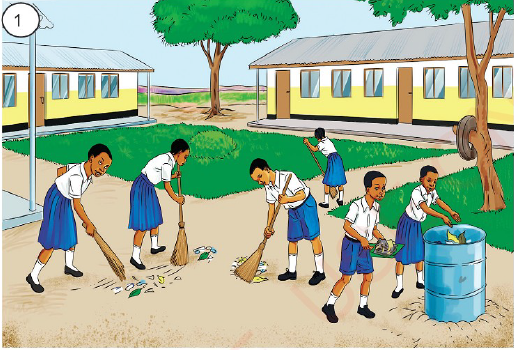 |
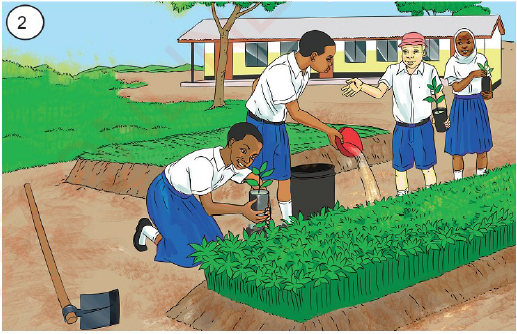 |
| Figure 1: Conserving the school environment |
Exercise
1. What do you see in picture 1 and 2?
2. Describe the school environment in picture 1.
3. Compare the school environment shown in picture 1 with your school environment.
4. Make a list of activities that could make your school environment look similar to the environment shown in picture 1 .
5. What are the pupils in picture 2 holding?
6. List kinds of behaviour which make your school environment dirty.
7. List things which enhance the good reputation of your school.
8. Which sports and games will you participate in to make your school famous?
9. What else should you, your fellows, and teachers do to make your school famous. (Distinguish the roles of pupils and teachers.)
| Activity Discuss with your environmental teacher the challenges you face in keeping your school environment clean and how you can overcome them. Write your recommendations and submit them to your subject teacher. |
The school emblem
| Ask Yourself Does your school have an 'emblem?' What do you understand by the emblem? What is your school motto? |
An emblem is a special symbol that is used to signify or identify something. The school emblem is used to identify a particular school. Usually, in the school emblem, you find the school motto and important school activities including the school environment.
Participating in voluntary activities at school
| Think Have you ever been engaged in voluntary activities at your school? How activity did you feel? What activity did you participate in? |
Volunteering occurs when you do something for a group or community without being asked to do so and without expecting anything in return. For example, you may volunteer to plant trees or flowers in the school compound or establish a vegetable garden. You may also establish or join a club such as a scout club, an environment club, a HIV/AIDS club, an anticorruption club, or a tax club. Additionally, you may participate in preparing bricks for constructing a school office, classroom, and school toilets.
You may also participate in different self-reliance activities for raising your school income. Such activities can be conducting agriculture and livestock keeping, establishing a tree nursery, and joining vocational studies at school.
| Exercise 1. What is the importance of the school emblem? 2. Identify the basic features contained in your school emblem. 3. Have you ever participated in voluntary activities either at your school or in the community? List them. 4. Considering the passage above, in which activities are you ready to participate? |
Values of our country
Values are all things that we feel proud to have. Our values include the Kiswahili language, national unity, patriotism, solidarity, accountability, love, respect and human dignity. It is our duty to cherish our values which identify our country. It is also important to respect our traditions and norms as well as to promote our culture as part of our national values.
Customs and traditions of our country
| Think Has anyone ever asked you to preserve customs and traditions of your country? What do they mean? |
Customs and traditions relate to how our communities are used to do things for a long time. These are inherited from one generation to another. They are part of the culture of a particular community. Therefore, they help to identify that community. In Tanzania, customs and traditions distinguish different communities. Some are good while others are bad.
In order to promote national culture, we need to encourage good customs and traditions and discourage the bad ones. Bad customs and traditions hinder development at family, community, and national levels.
Table 1: Good and bad customs and traditions
| Good customs and traditions | Bad customs and traditions |
| Encourage all people to work hard and cooperatively. | Require only women to work hard for the whole family while men contribute little or nothing. |
| The youth attend jando initiation ceremonies, and they are provided with appropriate training. They are taught customs and traditions of the community to prepare them to fulfill their responsibilities. | Some communities practise female genital mutilation and improper dance styles like kumcheza mwali or vigodoro (which are seductive). |
| Encourage family members of both sexes to cooperate in performing household chores and in generating income. | Exempting boys from performing household chores like cooking and cleaning utensils. |
| Work distribution considers equality between men and women. | Work distribution does not consider equality between men and women. |
| Children's rights are respected. | Children's rights are violated. |
| Exercise 1 List other bad customs and traditions you know. 2 List good customs and traditions that exist in your community. 3 List other traditional dances that humiliate women in your community. 4 Write what can be done to stop the bad customs and traditions listed in Table 1. |
We may define culture as a way of life which includes the origin, traditions, customs, and dominant ideas of a particular community. We may also define culture as a total way of life. Therefore, preserving national culture needs to consider good customs and traditions as well as all other aspects which promote unity in the nation.
Importance of culture
Our nation derives its identity from culture. In addition, culture promotes self-confidence and self-value. For example, Kiswahili identifies Tanzania in a special way. When Tanzanian artists travel to other countries, they identify themselves as Tanzanians through their works of art and performances. In addition, culture promotes unity, love, cooperation, and mutual respect.
Culture preserves customs and traditions of our communities through training such as jando and unyago in some societies. Such training enables the youth to live responsibly in their communities. Culture encourages people to work hard using the acquired knowledge and skills. Works of art such as carvings, musical compositions, sport and dances contribute to personal, community, and national income.
Moreover, people get different kinds of entertainment through culture. Traditional songs and dances are often used by some communities to raise work morale and promote discipline. For example, the Sukuma hit drums when they are cultivating farms in order to boost the morale of the cultivators.
We may preserve our culture in different ways. One way is to participate in cultural activities. Another way is to use our mother tongue and our Kiswahili national language, depending on the context. We also have to proudly wear traditional clothes, to cherish good customs and traditions, and to eat our locally produced and prepared foodstuffs. We should also honour customs and traditions that encourage good neighbourliness. Moreover, we should respect traditional ways of greeting each other. Usually, children and youth are supposed to begin greeting the elders. In brief, culture is the life-blood of our society.
Study the following pictures and answer the questions that follow.
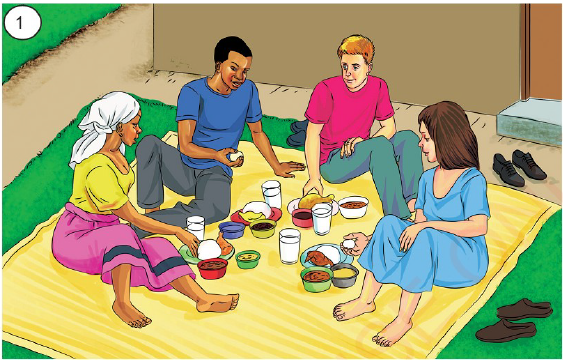 |
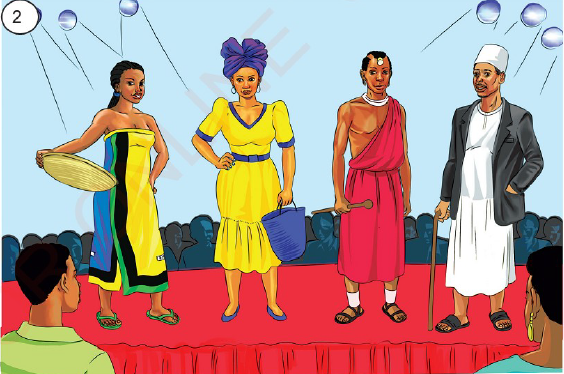 |
| Figure 2: Acts of preserving and promoting our culture |
| Exercise 1. What do you see in picture 1 and 2? 2. List the advantages of the acts shown in both pictures?. 3. List the things held by people shown in picture 2. |
| Activity Discuss with your parent(s) or guardian(s) the traditional musical instruments used in your community; then, draw the instrument(s) and submit your work to your subject teacher. |
National symbols
The National symbols include the National Anthem, National Flag, The Giraffe, National Emblem (or Coat ofArms), National Currency, Presidential Flag, IJhuru Torch, Constitution of the United Republic of Tanzania as well as the map of Tanzania.
The symbols are used on particular occasions and for specific purposes. Let us now look at how the symbols are used.
The National Flag
The national flag is a symbol of our nation. It differentiates our nation from other nations. Our national flag flies in all countries where Tanzania has opened high commissioners' offices. Additionally, when national leaders and some citizens travel outside the country, they take the national flag with them in order to represent our country.
The national flag also shows the vehicles which are registered in Tanzania. These include ships, aircraft, cars and motorbikes. In addition, the national flag is used to identify public offices or institutions such as schools, villages, wards, districts and regional offices, courts, and ministerial offices.
You probably have seen the national flag flying at half-mast. This is when the nation mourns a national disaster such as the death of a national leader such as the father of the nation, Mwalimu Julius Kambarage Nyerere, the sinking of MV Bukoba on 21 st May 1996, and the sinking of MV Nyerere on 20th September 2018 in Lake Victoria. Many people died from the disasters.
The National Anthem
The national anthem is used in almost similar ways to the national flag. It is sung when a national leader visits another country and when Tanzanian teams travel outside the country for tournaments or cultural performances. The national anthem is also sung to decree the death of a national leader such as the President, Vice President, or Prime Minister.
Moreover, when the President launches something of national importance, the national anthem is sung. Some examples are national celebrations, a new ship, a new aeroplane, or a state banquet in honour of a visiting President. In schools and defence forces, the national anthem is sung in order to inculcate a sense of patriotism.
The Giraffe
That animal is the giraffe. Its picture is used as a watermark in Tanzania's banknotes. It is also used together with the national flag to identify the aeroplanes owned by the government of the United Republic of Tanzania. Likewise, the images of the giraffe on the tails of such planes signify the country's natural resources.
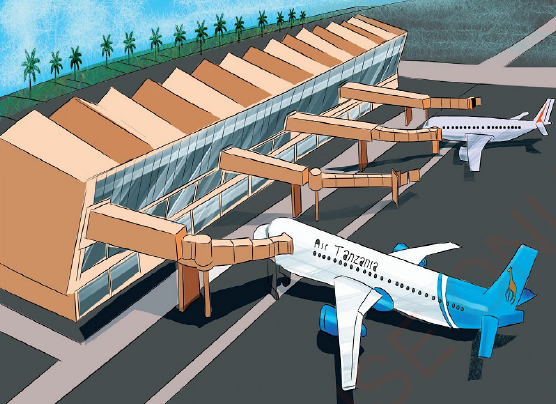 Figure 3: The image of the giraffe on the tail of a Tanzanian aeroplane |
The National Emblem or Coat of Arms
| Think Have you ever seen the national emblem? What does it contain? Where did you see it? |
The national emblem contains the following thirteen symbols:
1. A woman and a man: They signify unity among Tanzanians.
2. The uhuru torch: It signifies our independence from colonialism; it also represents unity, love, and hope.
3. Elephant tusks: They represent wild life resources in our country.
4. The peak of Mount Kilimanjaro: It is the highest mountain in Africa, and it signifies the pride of Tanzania.
5. Sea waves: They represent the water bodies found in Tanzania.
6. The national flag: It signifies national sovereignty.
7. The spear: It stands for national defence.
8. Cotton and clove: These represent the cash crops produced in Tanzania.
9. The hoe: It represents farmers.
10. The axe: It represents workers.
11. National Motto - UHURU NA UMOJA: Means freedom and unity.
12. The red portion: It represents the fertile land found in Tanzania.
13. The yellow portion: It represents mineral resources found in Tanzania. The national emblem is used to signify government ownership of documents and assets. It is seen in all government publications, books, national passports, and uniforms of high-ranking military officers. It is also used in official communication and announcements. The President's seal also shows the national emblem.
The Tanzanian Currency
The currency is one of our national symbols. Our currency is known as the Tanzanian shilling. It serves two functions. The first function is identifying Tanzania as an independent country, and the second is measuring the value of goods and services. Therefore, we should take good care of our currency, both in the form of banknotes and coins.
The Presidential Flag
The Presidential flag is used to symbolise the authority of the President of the IJnited Republic of Tanzania during official functions in and outside the country. It is also flown on the President's official transport and the state house.
The Uhuru Torch
The uhuru torch was lit for the first time when our country got independence on 9 t' December 1961. It symbolises Tanzania's independence and solidarity among people. Every year, the uhuru torch is carried around the country in a ritual known as the Uhuru torch race. During the race, many development projects are launched. A special song is sung to remind the citizens to fulfill their responsibility of defending the nation.
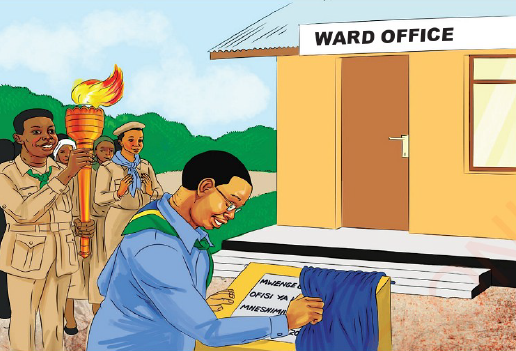 Figure 4: Inaugurating development projects during the uhuru torch race |
Sing the song Kuwasha Mwenge and think about its contents.
Its lyrics are presented below:
'Kuwasha Mwenge'
Sisi tumekwisha uwasha Mwenge
Tumekwisha uwasha Mwenge
Na kuuweka juu ya mlima,
Mlima Kilimanjaro Kuwasha Mwenge
Kuwasha Mwenge
Na kuuweka Kilimanjaro
Umulike hata nje ya mipaka yetu, ulete tumaini,
Pale ambapo hakuna matumaini,
Upendo mahali ambapo pana chuki
Na heshima ambapo pamejaa dharau
The Constitution of the United Republic of Tanzania
A constitution is a set of laws and basic principles that govern the activities of a country, a political party, or a group of people who share the same goals. Tanzania is governed by the constitution of the United Republic of Tanzania, which is the mother law. It provides the basic principles governing politics, structure, jurisdictions, and functions of the government. It also stipulates the rights and responsibilities of the Tanzanian.
The constitution of the United Republic of Tanzania is also one of the symbols of our nation. It is used to preserve and protect all the laws made by the parliament of the United Republic of Tanzania. It stipulates the separation of powers between the three pillars of the state. The pillars are the executive, the parliament, and the judiciary. The constitution is used when key national leaders are sworn in after being elected or appointed. When the leaders are sworn in, they pledge to defend and uphold the constitution of the United Republic of Tanzania. Additionally, the constitution stipulates clearly the scope and functions of each leader to prevent conflicts while executing their responsibilities. It also preserves laws that protect the interests and rights of human beings.
The Map of Tanzania
The map ofTanzania is used to show boundaries between our country and the neighbouring countries. To the east, Tanzania is bounded by the Indian Ocean. To the west, the country is bordered by Burundi, the Democratic Republic of Congo and Rwanda. To the south, it is bordered by Malawi, Mozambique, and Zambia. To the north, Tanzania is bordered by Kenya and Uganda.
Exercise
1 How many national symbols does Tanzania have? Name them.
2 How many signs does the national emblem contain? List them.
3 Identify two forms of the Tanzanian currency.
4 List the benefits of the Uhuru torch to Tanzania.
5 List the values of Tanzania.
6 Explain the benefits of the national constitution to Tanzanians.
7 Which patriotic aspects does the song Kuwasha Mwenge promote?
| Ask yourself Which national festivals do you remember? Which of the national festivals have you participated in as a pupil? |
National festivals are special days that are observed nationally to commemorate important national events. The following list contains national festivals observed in Tanzania.
Table 2: National festivals
| Date | Events observed/remembered |
| 12 January | The Zanzibar Revolution |
| 7 April | Death of the first president of Zanzibar, Sheikh Abeid Aman Karume |
| 26 April | The Union of Tanganyika and Zanzibar to form Tanzania |
| 1 May | Workers' Day |
| 7 July | International Trade Fair |
| 8 August | Farmers' Day |
| 14 October | Death of the first President of the United Republic of Tanzania, Mwalimu Julius Kambarage Nyerere |
| 9 December | Independence Day |
There are also religious festival days for Christians and Muslims. Christians' festival days include Christmas, Good Friday, Easter and Easter Monday. Muslims' festival days are Eid-El Fitr, Eid-El Haj, and Maulid.
The importance of national festivals
National festivals are occasions on which we cherish important past events and the meaning attached to such events. On such occasions, national leaders get opportunities to explain the achievements of the country overtime, the development challenges to be tackled, and the way forward. For example, on Farmers' Day, which is celebrated on 8th August every year, our leaders ask farmers to visit agricultural exhibitions to learn new strategies for increasing efficiency and productivity in farming and livestock activities. Citizens have the opportunity to listen to and communicate with their experts, while reflecting on the challenges they encounter. For example, on May 1 st, workers express their grievances which need the attention of decision makers at national level.
| Exercise 1. What is the importance of celebrating the following national festivals?
2 Which benefits do workers get when celebrating Workers' Day? 3 What are the benefits of Farmers' Day to our nation? |
Exercise
Choose the correct answer and write its letter in your exercise book.
1 Which one of the following signifies national mourning?
- All flags fly at half-mast.
- The national flag flies at half-mast.
- The national flag is not hoisted on that day.
2 The national flag on transport vessels like ships and aeroplanes signifies that .
- they come from Tanzania or owned by Tanzania
- they are used in Tanzania only
- they are used by Tanzanians when they are outside the country
3 The symbol that is used to show that the assets and documents are owned by the government is
- the photo of the Vice President
- the national flag
- the national emblem
4 The source of all laws in Tanzania is
- the Tanzanian currency.
- the constitution of the United Republic of Tanzania
- the political parties.
5 Occasions on which national leaders get the opportunity to talk about national achievements and developmental challenges to be addressed
- Only during the uhuru torch race
- Zanzibar revolution day only
- National festivals
6 The President's flag is used for
- accompanying the President to various places.
- showing the authority of the President.
- campaigning for the uhuru torch.
7 Blue colour in the national flag is used to represent .
- Tanzanians.
- minerals.
- water bodies such as rivers, lakes and ocean in Tanzania.
8 On which of the following occasions is the national anthem sung?
- In important national events, different national institutions and international competitions
- When court proceedings begin
- Only when the President addresses the nation
9 When was the uhuru torch first lit?
- 9/12/1962
- 9/12/1961
- 26/4/1964
10 The following are some of the features found in the Tanzania currency:
- Giraffe, elephant, emblem and President's face
- Emblem, mule, and rhinoceros
- Torch, giraffe, and chimpanzee
11 Culture means
- advocacy for something that you like so much.
- a total way of life of people in a particular community or nation.
- traditional activities done by certain people.
12 A good school is marked by the following features:
- A good school band that attracts pupils from neighbouring schools to come and join school
- A clean environment, smartly dressed pupils, outstanding performance in national examinations and disciplined pupils
- Punctuality
13 Which of the following clubs can be established at school?
- Scout, Environment club, PCCB club, subject clubs
- Upatu, cooperative associations and political parties
- Scout, singeli and traditional dances.
14 Unity, patriotism, cooperation, love, respect, human dignity, are some of our cherished values, we must ...
- always read and write about them.
- encourage all citizens to read them.
- respect and cherish them.
15 Which of the following traditions is bad in the community?
- Cooperating with others
- Female genital mutilation
- Encouraging men and women to cooperate in raising family income
Vocabulary
| Constitution | a system of laws or basic principles which a state, country or group is governed by |
| Grievance | something that you think is unfair and you need to complain or protest about |
| Humiliate | to make someone feel ashamed or stupid and lose the respect of other people |
| PCCB | Prevention and Combating of Corruption Bureau |
| Pillar | a strong supporter of something |
| Preserve | continue doing or having something because it is good |
www.learninghubtz.co.tz
Hub App
 For Call,Sms&WhatsApp: 255769929722 / 255754805256
For Call,Sms&WhatsApp: 255769929722 / 255754805256
 For Call,Sms&WhatsApp: 255769929722 / 255754805256
For Call,Sms&WhatsApp: 255769929722 / 255754805256
WHATSAPP US NOW FOR ANY QUERY
App Ya Learning Hub Tanzania






